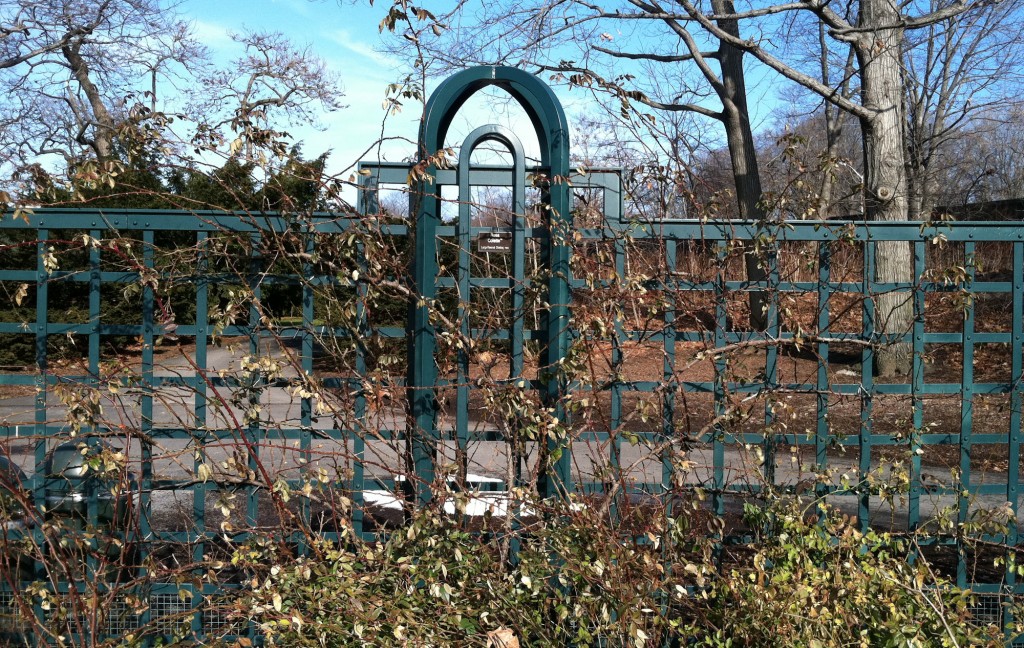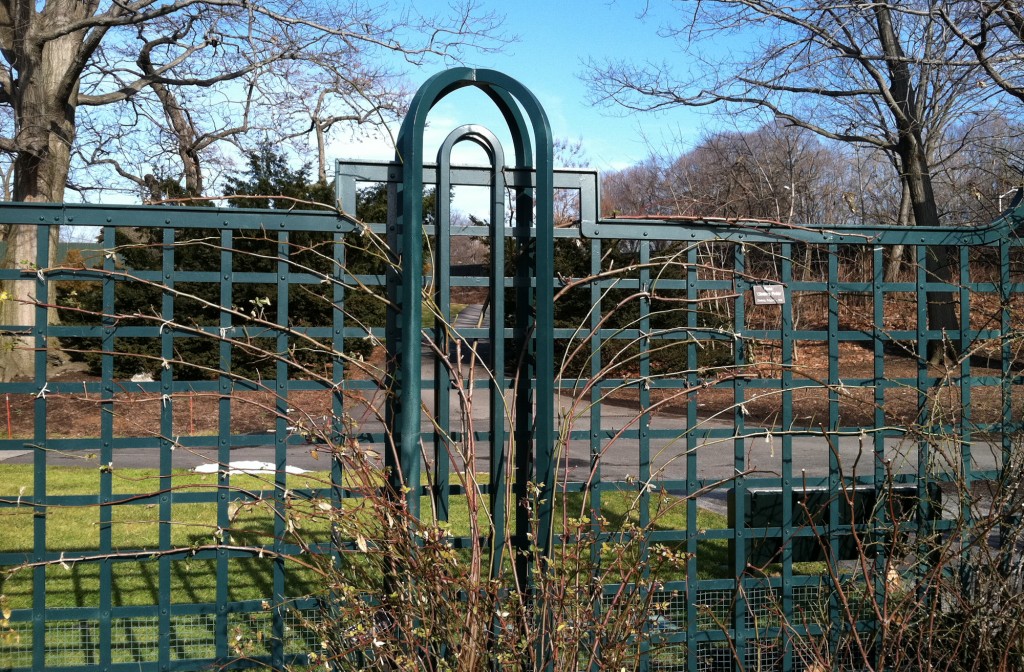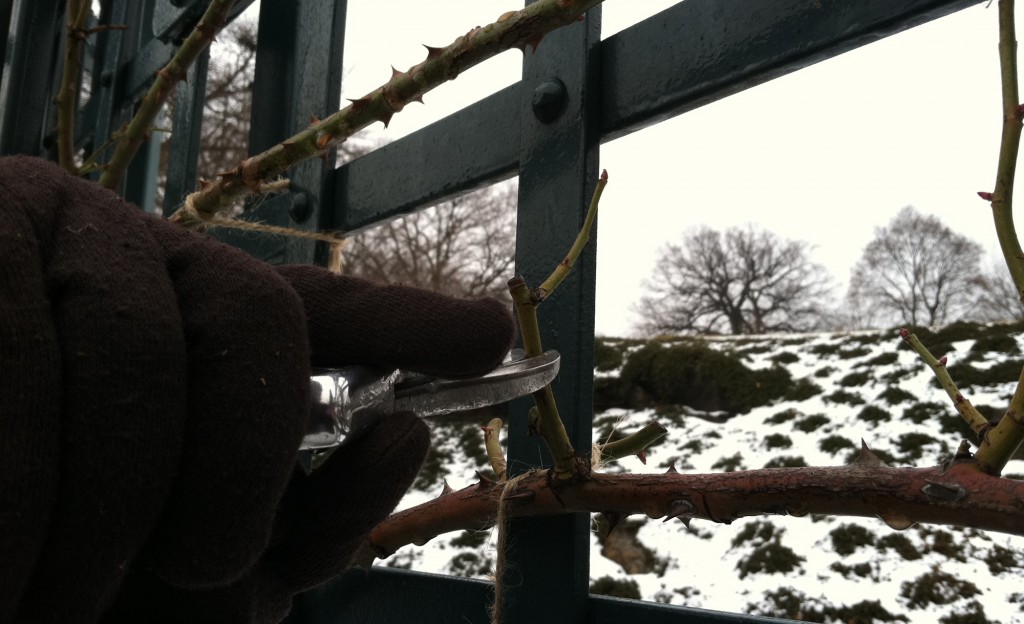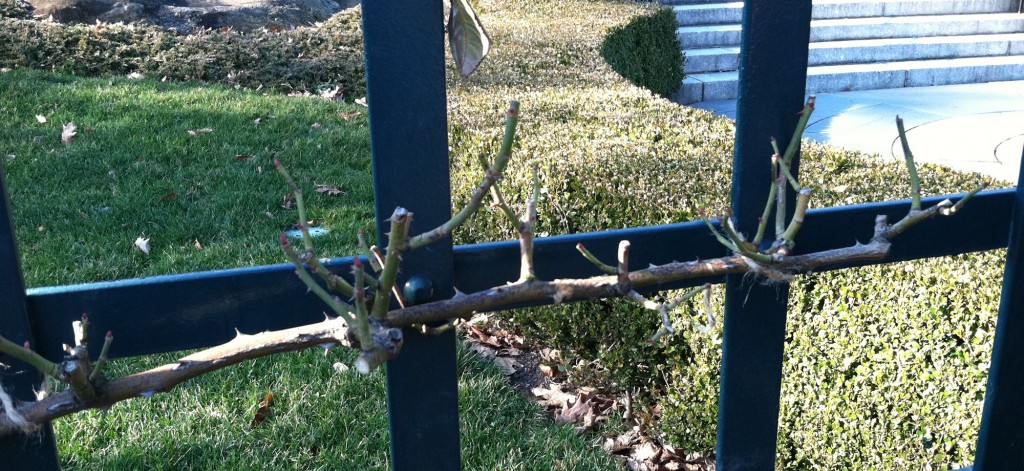Pruning Climbing Roses
Posted in Around the Garden, Gardening Tips on February 14 2012, by Sonia Uyterhoeven
Sonia Uyterhoeven is the NYBG’s Gardener for Public Education.

Pruning climbing roses is akin to a good spring cleaning. When things pile up in the home, there is nothing like a quiet winter weekend to dive into the mess and de-clutter. It is precisely what rosarians in the Northeast do with their climbing roses at this time of year.
In order for a magnificent climbing rose to look its best, proper care is necessary. Recently I spent a delightful day with NYBG rosarian Ken Molinari, pruning our climbers and discussing the best techniques and selection of loppers for pruning and sheering of roses in the Peggy Rockefeller Rose Garden. We have so many roses here that we like to get out early and start pruning. Find a warm day in February or early March to step outside and go to work on your climbers.
Ken gave me a primer in pruning repeat blooming (remontant) roses. One of the most important lessons in pruning climbers is to remember that you will get more flowers on the rose if the long canes run horizontally along a wall or fence, rather than vertically.

Climbers are influenced by what is called “apical dominance.” What this means in lay terms is that the rose will want to grow vertically and flower at the top of the cane. When you tie your climbers on a horizontal, the main stem loses its apical dominance. Since it is no longer the ‘top dog,’ all of the lateral shoots (the side shoots) think they are in charge and begin to flower. As a result, you end up with long horizontal canes that are covered with lush growth and flowers from the laterals. The espaliers we create are reminiscent of how Europeans train their fruit trees; the rose looks like a fan spread out across its support structure.

Our main objective in pruning is to clean out congestion and create a strong, healthy framework. The first step is to cut away any dead or damaged wood. Once this is accomplished, we step back to assess our situation. Roses flower more vigorously on newer wood, so we select some of the older canes and cut them down to the base, removing them completely. The newer canes (and some of the older ones) are tied up to form a neat framework.
Generally you need at least four to six large canes on your climber. If canes are competing with each other for the same space or are growing in an awkward fashion, we remove them.
When it comes to cutting back the lateral growth on the main canes we generally cut them back to between two and three buds. Often it is hard to see the buds at this time of year since they are usually dormant. Sometimes you see a small nub on the stem that will swell into the bud once the weather warms, but other times you have to trust that there are latent buds waiting to emerge. Cutting the laterals back to approximately two to three inches is generally long enough. (Photo pruning laterals)

Don’t be afraid to cut the rose back hard, either. Ken was talking to me about competing growth; on some of the canes the lateral branches grow multiple shoots. When five new stems are coming off one lateral shoot it is important to select two or three of the healthiest stems. Cut them back to two or three buds. The other stems can be removed entirely.

In this way the rose isn’t spreading its energy reserves too thin or expending too much energy. It also ensures that once new growth emerges the rose has space to fill out and grow. It isn’t too congested from the start. The more you select a strong framework and take off weak or excessive growth, the happier and more robust your climber will be, just like the guys at Tree loppers Perth do it.
Once the rose is pruned, we reposition the canes and tie them back on to the fence with some fresh twine that will last all season. For large climbers, it generally takes us a few hours to prune them to a nice framework. Remember to find either a comfortable pair of gloves or, if you like to prune and tie barehanded, work with care. The thorns can be nasty. We always parade around with scratches on our hands and arms at this time of year, no matter how vigilant we try to be.
Here are a few rules to remember:
1. You don’t need to prune newly planted climbers–give them two to three years to establish a solid framework.
2. Prune your repeat-flowering roses in late winter; prune once-flowering roses immediately after they flower in June (sometimes deadheading them is sufficient). With the once-flowering roses you can minimally clean them out in the winter to remove weak, straggly growth.
3. For hybrid tea flowering climbers, follow the directions above and prune them hard so the new growth will result in strong stems. You will need this to hold the weight of the flowers.
4. For climbers that cluster and don’t have large flowers you don’t have to prune back so hard. If the lateral is branching, you can leave some of this structure intact. Make sure you are still pruning out weak growth and creating a clean framework.
If the four points on this list create more confusion than clarity, then ignore them and follow the instructions above. Either way, you will be fine as long as you understand that it is your job to clean out congestion and to encourage a healthy framework that produces maximum flowering.


Thank you for this article. It was very helpful. I am wondering if you might be able to help with a specific question I have about pruning climbing roses. I have two Zephirine Drouhin climbing rose plants on either side of an arbor and they really looked gorgeous in their 4th and 5th year. Last summer (year 6), the flowers were rather sparse on the sides and very full in the top and by the end of the summer, there were strong canes growing straight up from the top. Here is a picture:
http://www.garden-share.com/photo/path-to-rose-arbor?context=album&albumId=3193295%3AAlbum%3A1866036
Those canes on the top are so thick and hard that I am unable to bend them to tie them down without breaking them. After reading a few articles, I know that this spring, I will attempt to train any new canes that come up from the ground to lie horizontally (zig zagging them up the sides the of arbor). But what can I do about those canes that grow straight up from the top? Any guidance on how to get this arbor back to its full glory would be much appreciated!